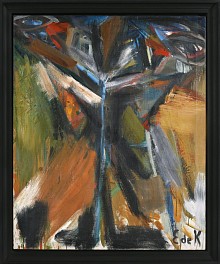BIOGRAPHY

ELAINE DE KOONING (1918-1989)
Elaine de Kooning was a prolific artist, critic, and teacher during the post-war era until her death. Like many other women artists of her generation, de Kooning received less attention in the mid- and late twentieth century from the press and public than her male counterparts, most notably her husband, Willem de Kooning. However, the steadfast creativity and accomplishment of de Kooning and other women of her time have become increasingly acknowledged and given overdue consideration. Among the recent efforts at such restitution was the 2016 groundbreaking exhibition, Women of Abstract Expressionism, held at the Denver Art Museum, curated by University of Denver professor Gwen F. Chanzit. In the show, de Kooning’s work is featured along with that of Perle Fine, Helen Frankenthaler, Judith Godwin, Grace Hartigan, Elaine de Kooning, Lee Krasner, and Joan Mitchell, among others. Recently she was the featured artist in the book, Ninth Street Women (2018), written by Mary Gabriel.
Although Born on March 12, 1918, in Brooklyn, Elaine Fried was exposed to art through frequent museum and gallery visits with her mother from a young age. Shortly after enrolling at Hunter College, New York, she withdrew in 1937 and began studying art at the Leonardo da Vinci Art School, New York, with Conrad Marca-Relli, who became a close friend. She also took drawing classes from the man who would eventually become her husband, Willem de Kooning, in 1938. Her early works are still lifes and portraits distinctly influenced by Cubism, but in the mid- to late 1940s she began making abstract paintings as well as writing art criticism. She worked as an editorial associate at Art News under Thomas Hess, writing some of the first significant essays on Mark Rothko Arshile Gorky, Hans Hofmann, and Franz Kline, and making Abstract Expressionism accessible to a broader audience. In 1948, De Kooning spent the summer at Black Mountain College near Asheville, North Carolina, where she played the title role in a production of Erik Satie’s Le piège de Méduse (The Ruse of Medusa, 1948), produced by John Cage and Merce Cunningham, for which she also designed the sets. Her first solo exhibition was in 1952 at the Stable Gallery, New York, where she showed again in 1954 and 1956.
De Kooning was a founding member of the Club, a group of avant-garde artists that met in Greenwich Village to discuss and debate art from 1949 until 1962. Though a fierce defender of Abstract Expressionism, she eventually became known for her portraits, particularly of men. After receiving a teaching appointment at the University of New Mexico, Albuquerque, in 1958, she traveled to Ciudad Juárez, Mexico, where she saw her first bullfight. The experience inspired a series of bull paintings on horizontal canvases, rendered in a bolder palette than that of her previous work. In 1961 she was included in the Whitney Annual (later the Whitney Biennial), New York, and in 1962 was commissioned to paint John F. Kennedy’s portrait, in part because of her reputation for quick execution. Despite an entire year obsessively working on the portrait, after the president’s death in 1964 she ceased painting altogether for another year.
From the late 1940s to the early 1980s, De Kooning painted basketball players at play using a loose, expressionistic style, and in the 1980s made a series of quasi-figurative, orgiastic paintings titled Bacchus. In 1983 she visited the Paleolithic caves in Lascaux, France, and began a series of paintings based on the cave paintings, titled Cave Walls, in which outlines of animals such as deer, bison, and goats, are rendered against turbulent grounds of dense brushstrokes. Toward the end of her life, she also made a number of works on paper in ink, continuing with the theme of cave paintings.
De Kooning had several solo gallery shows at museums including the Montclair Art Museum, New Jersey (1973), Guild Hall Museum, East Hampton, New York (1989), and the National Portrait Gallery (2015-16). Her work was featured in the Museum of Modern Art’s organized exhibition, Young American Painters (1956–58), which traveled throughout the United States (but was not presented in New York). De Kooning was also included in group shows at Walker Art Center, Minneapolis (1956); Pittsburgh International (now Carnegie International, 1956); Art Institute of Chicago (1964); Hirshhorn Museum and Sculpture Garden, Washington, D.C. (1980); and Guild Hall Museum, East Hampton (1990).
Elaine de Kooning is represented in many important private and public collections throughout the country, including the Denver Art Museum; the Metropolitan Museum of Art, New York; the Museum of Modern Art, New York; the National Portrait Gallery, Washington, DC; and the Solomon R. Guggenheim Museum, New York, among many others.
